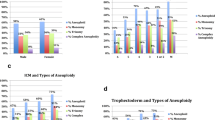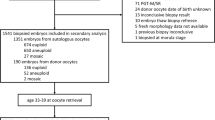Abstract
Purpose
The goal is to determine if variations exist between male and female blastocysts in preimplantation measurements of quality and ploidy and in vitro fertilization elective single-embryo transfer (eSET) outcomes.
Methods
A retrospective chart review was conducted from a private fertility center’s database of blastocysts undergoing preimplantation genetic testing for aneuploidy, along with details of eSET from this screened cohort. Main outcomes included preimplantation embryo quality and sex-specific eSET outcomes.
Results
A total of 3708 embryos from 578 women were evaluated, with 45.9% male and 54.1% female. The majority were High grade. No difference existed between embryo sex and overall morphological grade, inner cell mass or trophectoderm grade, or blastocyst transformation day. Female blastocysts had a higher aneuploidy rate than male blastocysts (P < 0.001). Five hundred thirty-nine eSETs from 392 women were evaluated, with High grade embryos more likely to have implantation (P < 0.001), clinical pregnancy (P < 0.001), and ongoing pregnancy (P = 0.018) than Mid or Low grade embryos. Day 5 blastocysts were more likely to have implantation (P = 0.018), clinical pregnancy (P = 0.005), and ongoing pregnancy (P = 0.018) than day 6 blastocysts. Male and female embryos had similar transfer outcomes, although female day 5 blastocysts were more likely to result in clinical pregnancy (P = 0.012), but not ongoing pregnancy, than female day 6 blastocysts. Male eSET outcomes did not differ by blastocyst transformation day.
Conclusion
Male and female embryos have comparable grade and quality; however, female embryos were more likely to be aneuploid. Ongoing pregnancy rates did not differ by embryo sex. Day 5 embryos had more favorable transfer outcomes than day 6 embryos.
Similar content being viewed by others
Data availability
Data will be made available upon request to the corresponding author.
Code availability
N/A
References
Dmowski WP, Gaynor L, Rao R, Lawrence M, Scommegna A. Use of albumin gradients for X and Y sperm separation and clinical experience with male sex preselection. Fertil Steril. 1979;31:52–7.
Beernink FJ, Dmowski WP, Ericsson RJ. Sex preselection through albumin separation of sperm. Fertil Steril. 1993;59:382–6.
Chang J, Boulet SL, Jeng G, Flowers L, Kissin DM. Outcomes of in vitro fertilization with preimplantation genetic diagnosis: an analysis of the United States Assisted Reproductive Technology Surveillance Data, 2011-2012. Fertil Steril. 2016;105:394–400.
Ginsburg ES, Baker VL, Racowsky C, Wantman E, Goldfarb J, Stern JE. Use of preimplantation genetic diagnosis and preimplantation genetic screening in the United States: a Society for Assisted Reproductive Technology Writing Group paper. Fertil Steril. 2011;96:865–8.
Ethics Committee of the American Society for Reproductive Medicine. Use of reproductive technology for sex selection for nonmedical reasons. Fertil Steril. 2015;103:1418–22.
Capelouto SM, Archer SR, Morris JR, Kawwass JF, Hipp HS. Sex selection for non-medical indications: a survey of current pre-implantation genetic screening practices among U.S. ART clinics. J Assist Reprod Genet. 2018;35:409–16.
Glujovsky D, Farquhar C, Quinteiro Retamar AM, Alvarez Sedo CR, Blake D. Cleavage stage versus blastocyst stage embryo transfer in assisted reproductive technology. Cochrane Database Syst Rev. 2016;30:CD002118.
Glujovsky D, Farquhar C. Cleavage-stage or blastocyst transfer: what are the benefits and harms? Fertil Steril. 2016;106:244–50.
Sotiroska V, Petanovski Z, Dimitrov G, Hadji-Lega M, Shushleski D, Saltirovski S, et al. The day of embryo transfer affects delivery rate, birth weights, female-to-male ratio, and monozygotic twin rate. Taiwan J Obstet Gynecol. 2015;54:716–21.
Munné S, Kaplan B, Frattarelli JL, Child T, Nakhuda G, Shamma FN, et al. Preimplantation genetic testing for aneuploidy versus morphology as selection criteria for single frozen-thawed embryo transfer in good-prognosis patients: a multicenter randomized clinical trial. Fertil Steril. 2019;112:1071–9.
Milki AA, Jun SH, Hinckley MD, Westphal LW, Giudice LC, Behr B. Comparison of the sex ratio with blastocyst transfer and cleavage stage transfer. J Assist Reprod Genet. 2003;20:323–6.
Ménézo YJ, Chouteau J, Torelló J, Girard A, Veiga A. Birth weight and sex ratio after transfer at the blastocyst stage in humans. Fertil Steril. 1999;72:221–4.
Alfarawati S, Fragouli E, Colls P, Stevens J, Gutiérrez-Mateo C, Schoolcraft WB, et al. The relationship between blastocyst morphology, chromosomal abnormality, and embryo gender. Fertil Steril. 2011;95:520–4.
Bronet F, Nogales MC, Martínez E, Ariza M, Rubio C, García-Velasco JA, et al. Is there a relationship between time-lapse parameters and embryo sex? Fertil Steril. 2015;103:396–401.
Gardner DK, Wale PL. Analysis of metabolism to select viable human embryos for transfer. Fertil Steril. 2013;99:1062–72.
Ebner T, Tritscher K, Mayer RB, Oppelt P, Duba HC, Maurer M, et al. Quantitative and qualitative trophectoderm grading allows for prediction of live birth and gender. J Assist Reprod Genet. 2016;33:49–57.
Gardner DK, Wale PL, Collins R, Lane M. Glucose consumption of single post-compaction human embryos is predictive of embryo sex and live birth outcome. Hum Reprod. 2011;26:1981–6.
Gardner DK, Larman MG, Thouas GA. Sex-related physiology of the preimplantation embryo. Mol Hum Reprod. 2010;16:539–47.
Tarín JJ, García-Pérez MA, Hermenegildo C, Cano A. Changes in sex ratio from fertilization to birth in assisted-reproductive-treatment cycles. Reprod Biol Endocrinol. 2014;12:56.
Csokmay JM, Hill MJ, Cioppettini FV, Miller KA, Scott RT Jr, Frattarelli JL. Live birth sex ratios are not influenced by blastocyst-stage embryo transfer. Fertil Steril. 2009;92:913–7.
Richter KS, Anderson M, Osborn BH. Selection for faster development does not bias sex ratios resulting from blastocyst embryo transfer. Reprod Biomed Online. 2006;12:460–5.
Eaton JL, Hacker MR, Barrett CB, Thornton KL, Penzias AS. Influence of embryo sex on development to the blastocyst stage and euploidy. Fertil Steril. 2011;95:936–9.
Wang A, Kort J, Behr B, Westphal LM. Euploidy in relation to blastocyst sex and morphology. J Assist Reprod Genet. 2018;35:1565–72.
Haas J, Meriano J, Laskin C, Bentov Y, Barzilay E, Casper RF, et al. Clinical pregnancy rate following frozen embryo transfer is higher with blastocysts vitrified on day 5 than on day 6. J Assist Reprod Genet. 2016;33:1553–7.
Tubbing A, Shaw-Jackson C, Ameye L, Colin J, Rozenberg S, Autin C. Increased live births after day 5 versus day 6 transfers of vitrified-warmed blastocysts. J Assist Reprod Genet. 2018;35:417–4.
Poulsen V, Ingerslev HJ, Kirkegaard K. Elective embryo transfers on Day 6 reduce implantation compared with transfers on Day 5. Hum Reprod. 2017;32:1238–43.
Hill MJ, Richter KS, Heitmann RJ, Graham JR, Tucker MJ, DeCherney AH, et al. Trophectoderm grade predicts outcomes of single-blastocyst transfers. Fertil Steril. 2013;99:1283–9.
Richter KS, Ginsburg DK, Shipley SK, Lim J, Tucker MJ, Graham JR, et al. Factors associated with birth outcomes from cryopreserved blastocysts: experience from 4,597 autologous transfers of 7,597 cryopreserved blastocysts. Fertil Steril. 2016;106:354–62.
Chang HJ, Lee JR, Jee BC, Suh CS, Kim SH. Impact of blastocyst transfer on offspring sex ratio and the monozygotic twinning rate: a systematic review and meta-analysis. Fertil Steril. 2009;91:2381–90.
Kausche A, Jones GM, Trounson AO, Figueiredo F, MacLachlan V, Lolatgis N. Sex ratio and birth weights of infants born as a result of blastocyst transfers compared with early cleavage stage embryo transfers. Fertil Steril. 2001;76:688–93.
Klimczak AM, Pacheco LE, Lewis KE, Massahi N, Richards JP, Kearns WG, et al. Embryonal mitochondrial DNA: relationship to embryo quality and transfer outcomes. J Assist Reprod Genet. 2018;35:871–7.
Gardner DK, Schoolcraft WB. In vitro culture of human blastocyst. In: Jansen R, Mortimer D, editors. Towards Reproductive Certainty: Infertility and Genetics Beyond. Carnforth: Parthenon Press; 1999. p. 377–88.
Graffelman J, Fugger EF, Keyvanfar K, Schulman JD. Human live birth and sperm-sex ratios compared. Hum Reprod. 1999;14:2917–20.
Shaia K, Truong T, Pieper C, Steiner A. Pre-implantation genetic testing alters the sex ratio: an analysis of 91,805 embryo transfer cycles. J Assist Reprod Genet. 2020;37:1117–22.
Luna M, Duke M, Copperman A, Grunfeld L, Sandler B, Barritt J. Blastocyst embryo transfer is associated with a sex-ratio imbalance in favor of male offspring. Fertil Steril. 2007;87:519–23.
Dean JH, Chapman MG, Sullivan EA. The effect on human sex ratio at birth by assisted reproductive technology (ART) procedures—an assessment of babies born following single embryo transfers, Australia and New Zealand, 2002-2006. BJOG. 2010;117:1628–34.
Supramaniam PR, Mittal M, Ohuma EO, et al. Secondary sex ratio in assisted reproduction: an analysis of 1 376 454 treatment cycles performed in the UK. Hum Reprod Open. 2019;1–9.
Chen M, Du J, Zhao J, et al. The sex ratio of singleton and twin delivery offspring in assisted reproductive technology in China. Sci Rep. 2017;7:7754.
Barash OO, Ivani KA, Willman SP, Rosenbluth EM, Wachs DS, Hinckley MD, et al. Association between growth dynamics, morphological parameters, the chromosomal status of the blastocysts, and clinical outcomes in IVF PGS cycles with single embryo transfer. J Assist Reprod Genet. 2017;34:1007–16.
Shapiro BS, Richter KS, Harris DC, Daneshmand ST. A comparison of day 5 and day 6 blastocyst transfers. Fertil Steril. 2001;75:1126–30.
Barrenetxea G, López de Larruzea A, Ganzabal T, Jiménez R, Carbonero K, Mandiola M. Blastocyst culture after repeated failure of cleavage-stage embryo transfers: a comparison of day 5 and day 6 transfers. Fertil Steril. 2005;83:49–53.
Lou H, Li N, Zhang X, Sun L, Wang X, Hao D, et al. Does the sex ratio of singleton births after frozen single blastocyst transfer differ in relation to blastocyst development? Reprod Biol Endocrinol. 2020;18:72.
McCoy RC. Mosaicism in preimplantation human embryos: when chromosomal abnormalities are the norm. Trends Genet. 2017;33:448–63.
Fragouli E, Alfarawati S, Spath K, Wells D. Morphological and cytogenetic assessment of cleavage and blastocyst stage embryos. Mol Hum Reprod. 2014;20:117–26.
Capalbo A, Rienzi L. Mosaicism between trophectoderm and inner cell mass. Fertil Steril. 2017;107:1098–106.
Rosenwaks Z, Handyside AH, Fiorentino F, Gleicher N, Paulson RJ, Schattman GL, et al. The pros and cons of preimplantation genetic testing for aneuploidy: clinical and laboratory perspectives. Fertil Steril. 2018;110:353–61.
Author information
Authors and Affiliations
Contributions
All authors contributed to the study concept and design. CPM, SEF, JPR, and JRC collected the data. Data was analyzed by CPM, AFS, and JRC. The first draft of the manuscript was written by CPM, and all authors contributed to and approved the final version.
Corresponding author
Ethics declarations
Ethics approval
This study was deemed exempt by the Institutional Review Board of the University of Texas Medical Branch Galveston.
Conflict of interest
The authors declare no competing interests.
Additional information
Publisher’s note
Springer Nature remains neutral with regard to jurisdictional claims in published maps and institutional affiliations.
Rights and permissions
About this article
Cite this article
Moutos, C.P., Kearns, W.G., Farmer, S.E. et al. Embryo quality, ploidy, and transfer outcomes in male versus female blastocysts. J Assist Reprod Genet 38, 2363–2370 (2021). https://doi.org/10.1007/s10815-021-02250-w
Received:
Accepted:
Published:
Issue Date:
DOI: https://doi.org/10.1007/s10815-021-02250-w




